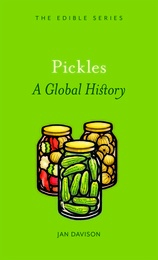14 start with P start with P

Pancake traverses over centuries and civilizations to examine the culinary and cultural importance of pancakes in human history. From the Russian blini to the Ethiopian injera, Albala reveals how pancakes have been a perennial source of sustenance from Greek and Roman eras to the Middle Ages through to the present day. He explores how the pancake has gained symbolic currency in diverse societies as a comfort food, a portable victual for travelers, a celebratory dish, and a breakfast meal. The book also features a number of historic and modern recipes—tracing the first official pancake recipe to a sixteenth-century Dutch cook—and is accompanied by a rich selection of illustrations.
Pancake is a witty and erudite history of a well-known favorite and will ensure that the pancake will never be flattened under the shadow of better known foods.

Shelke traces the evolution and examines the scientific qualities of this highly adaptable staple. From there she guides us from roadside noodle stalls in Singapore to an age-old traditional pasta company in Parma, Italy; from a state-of-the-art Japanese manufacturer to pasta makers in Brazil, Mexico, and United States. She then takes the quest into our homes, offering a bonanza of recipes from around the world suitable to casual and intrepid home-cooks alike. A toothsome look at the world’s comfort food, Pasta and Noodles reveals little known facts, tasty titbits, and cultural lore that will have you feeling satiated, indeed.

At the Berlin Auto Show in 1938, Adolf Hitler presented the prototype for a small, oddly shaped, inexpensive family car that all good Aryans could enjoy. Decades later, that automobile—the Volkswagen Beetle—was one of the most beloved in the world. Bernhard Rieger examines culture and technology, politics and economics, and industrial design and advertising genius to reveal how a car commissioned by Hitler and designed by Ferdinand Porsche became an exceptional global commodity on a par with Coca-Cola.
Beyond its quality and low cost, the Beetle’s success hinged on its uncanny ability to capture the imaginations of people across nations and cultures. In West Germany, it came to stand for the postwar “economic miracle” and helped propel Europe into the age of mass motorization. In the United States, it was embraced in the suburbs, and then prized by the hippie counterculture as an antidote to suburban conformity. As its popularity waned in the First World, the Beetle crawled across Mexico and Latin America, where it symbolized a sturdy toughness necessary to thrive amid economic instability.
Drawing from a wealth of sources in multiple languages, The People’s Car presents an international cast of characters—executives and engineers, journalists and advertisers, assembly line workers and car collectors, and everyday drivers—who made the Beetle into a global icon. The Beetle’s improbable story as a failed prestige project of the Third Reich which became a world-renowned brand illuminates the multiple origins, creative adaptations, and persisting inequalities that characterized twentieth-century globalization.

In Pickles, Jan Davison explores the cultural and gastronomic importance of pickles from the earliest civilizations’ brine-makers to twenty-first-century dilettantes of dill. Join Davison and discover the art of pickling as mastered by the ancient Chinese; find out why Korean astronaut Yi So-yeon took pickled cabbage into space in 2008; learn how the Japanese pickle the deadly puffer fish; and uncover the pickling provenance of that most popular of condiments, tomato ketchup. A compulsively consumable, globe-trotting tour sure to make you pucker, Davison’s book shows us how pickles have been omnipresent in humanity’s common quest not only to preserve foods, but to create them—with relish.

Apple pie. Pumpkin pie. Shepherd’s pie. Chicken potpie. Sweet or savory, pies are beloved; everyone has a favorite. Yet despite its widespread appeal there has never been a book devoted to this humble dish—until now.
Janet Clarkson in Pie illustrates how what was once a purely pragmatic dish of thick layers of dough has grown into an esteemed creation of culinary art. There is as much debate about how to perfect the ideal, flaky pastry crust as there is about the very definition of a pie: Must it have a top and bottom crust? Is a pasty a pie? In flavorful detail, Clarkson celebrates the pie in all its variations. She touches pon the pie’s commercial applications, nutritional value, and cultural significance; and she examines its international variations, from Britain’s pork pie and Australia and New Zealand’s endless varieties of meat pie to the Russian kurnik and good old-fashioned American apple pie.
This delectable salute to the many pies enjoyed the world over will satisfy the appetites of all readers hungry for culinary history and curious about the many varieties of this delightful food, and it just might inspire them to don aprons and head for the stove.


Originally a food for the poor in eighteenth-century Naples, the pizza is a source of national and regional pride as well as cultural identity in Italy, Helstosky reveals. In the twentieth century, the pizza followed Italian immigrants to America, where it became the nation’s most popular dish and fueled the rise of successful fast-food corporations such as Pizza Hut and Domino’s. Along the way, Helstosky explains, pizza has been adapted to local cuisines and has become a metaphor for cultural exchange. Pizza also features several recipes and a wealth of illustrations, including a photo of the world’s largest and most expensive pizza—sprinkled with edible 24-karat gold shavings and costing over $4000.

Stone takes us back to the early polytheistic religions and the important role that pomegranates had in their rituals. From there he shows how they came to be held in high esteem in Judaism, Christianity, and Islam alike, examining exciting new findings that further cement their importance: for instance, many historians believe now that it was a pomegranate, not an apple, that was the forbidden fruit in the Garden of Eden. Stone examines the allure that the pomegranate has had to a fascinating cast of famous figures, from ancient Assyrian King Ashurnasirpal to Tudor Queen Anne Boleyn, from Sandro Botticelli to Salvador Dalí. Drawing on text, image, and taste, Pomegranate is a cornucopia of strange and fascinating stories about a very special fruit.


Guffey charts the rise of the poster from the revolutionary lithographs that papered nineteenth-century London and Paris to twentieth-century works of propaganda, advertising, pop culture, and protest. Examining contemporary examples, she discusses Palestinian martyr posters and West African posters that describe voodoo activities or Internet con men, stopping along the way to uncover a rich variety of posters from the Soviet Union, China, the United States, and more. Featuring 150 stunning images, this illuminating book delivers a fresh look at the poster and offers revealing insights into the designs and practices of our twenty-first-century world.

From obscure Pre-Columbian beginnings in the Andes Mountains to global popularity today, the story of the potato is one of rags to riches. In Potato, esteemed culinary historian Andrew F. Smith reveals the captivating story of a once lowly vegetable that has changed—and continues to change—the world.
First domesticated by prehistoric people in the Andes, the potato has since been adopted by cultures around the globe. For instance, the potato was aggressively adopted by cooks in India and China, where it has become a dietary staple. In fact, these two countries now stand as the world’s largest potato producers. Nonetheless, despite its popularity, in this era of both fast food and health consciousness, the potato is now suffering negative publicity regarding its low nutritional value. Its health benefits continue to be debated, especially considering that the potato is most often associated with the ubiquitous but high-calorie french fry.
Potato is a captivating read that provides a concisely written but thoroughly researched account of the history, economy, politics, and gastronomy behind this beloved starch—as well as recipes. As loaded with goodies as a well-dressed baked potato, this book is comforting and satisfying.



READERS
Browse our collection.
PUBLISHERS
See BiblioVault's publisher services.
STUDENT SERVICES
Files for college accessibility offices.
UChicago Accessibility Resources
home | accessibility | search | about | contact us
BiblioVault ® 2001 - 2024
The University of Chicago Press









